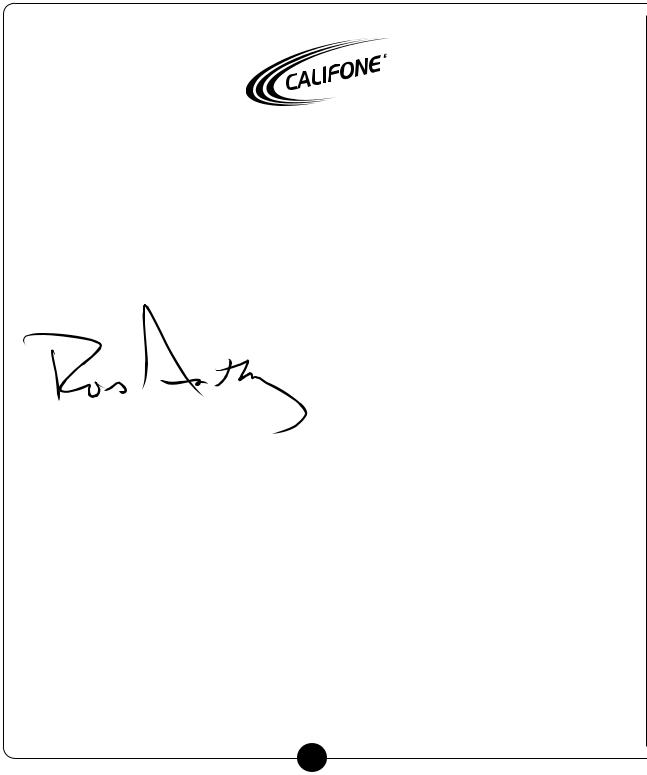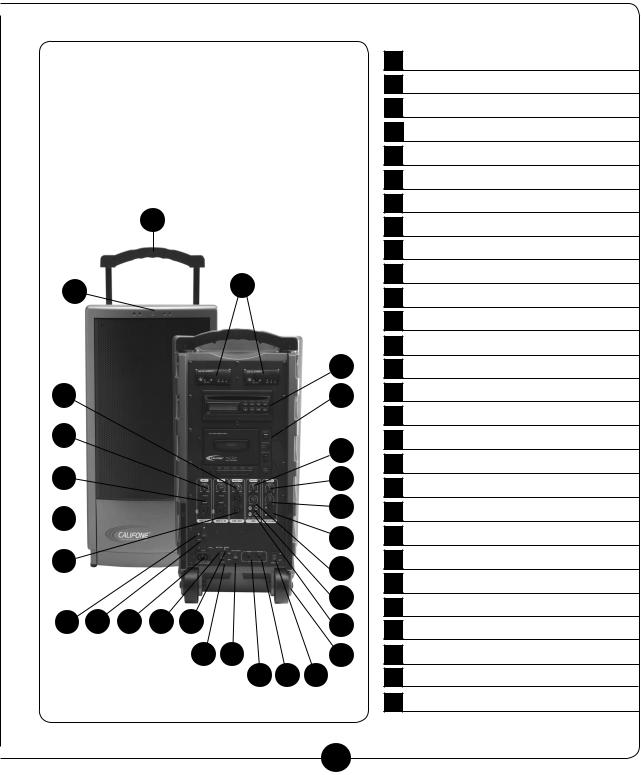Califone PA916-SP, PA916 User Manual

PowerPro 916
Portable
Public Address
Systems
Owner’s
Manual
PA916 Public Address Speaker
PA916-PS Powered Companion PA
PA916-SP Passive Companion Speaker

Power Pro 916 Owner’s Manual
Thank you for purchasing this PowerPro PA, the most versatile and appropriate portable PA for use in school, business, house of worship and government facilities.
I invite you to register your product online for warranty coverage at our website: www.califone.com — while you’re there — make sure to visit our complete line of multimedia players and recorders, wired and wireless headphones and headsets, computer peripherals and other Califone products.
While online, make sure you register your PowerPro for its limited six year warranty.
Sincerely,
Roscoe Anthony
President, Califone® International, Inc.
Unpacking
Check carefully for damage which may have taken place during transit. Report any damage claim directly to the freight carrier immediately. Save product(s) and packaging for inspection by the carrier’s claim agent. Notify your dealer of the pending claim.
Warranty Registration
Please register for your 6-year warranty online at www.califone.com to activate.
Service Repairs
Should your unit require repair contact the dealer or Califone Service Department at: (800) 722-0500 to obtain a Return Authorization number. After receiving the RA, ship the unit to Califone prepaid.
Collect shipments will be refused.
Contents
a)PowerPro Public Address System
b)Power Cord
c)Operation Manual
d)RC-300 Remote Control With 2 AAA Alkaline Batteries
e)6-Year Warranty & Registration Card
f)Project Intercept Card
Also included may be one or more of the following optional items:
•Q-316 Handheld 16-Channel Wireless UHF Microphone with 2 AA alkaline batteries.
•M-316 Beltpack Transmitter with 2 AA alkaline batteries.
•LM-316 Lapel Microphone for the M-316
•CM-316 Flexible Collar Microphone for the M-316
•HBM-316 Headband Microphone for the M-316
•PADM-558 High Quality Handheld Wired Microphone with cable and XLR Connector. (or other Califone cabled microphone.)
1

Power Pro 916
S p e c i f i c a t i o n s
1
28 |
2 |
|
8
5
6
7 
9
17 |
18 |
19 |
20 |
21 |
|
|
|
|
|
22 |
23 |
3
4
10
14
15
16
11
12
13
27
24 25 26
1Telescoping Handle
2Two 16-channel UHF wireless mic receivers
3Compact Disc Player
4Variable Speed Cassette Recorder/Player
5Microphone Volume (2)
6Speech/Music Switch (2)
7XLR & 1/4” Microphone Inputs(2)
8Audio Line Out Volume
9Audio Line Out XLR (2)
10CD-Tape On/Off & Volume
11Line-In Volume Control
12Line-In RCA Jacks
13Line-Out RCA Jacks
14Treble Control
15Bass Control
16Digital Master Volume
1716-channel UHF Transmitter
185 Ampere Fuse
19A/C Power Socket
20Battery Low/Charge Indicators
21Green Power On Indicator
22Power On/Off Switch
23Voice Priority (Ducking) Switch
241/4” Phone Jack Speaker Out
251/4” Phone Jack Speaker Out Switched
26Speaker Mute Switch
27Beefy 3.5” Integral Wheels
28LED Lights for Power, RF, Audio
2

Operation
Battery
Charge the battery for at least 10 hours before using the PA916 or PA916-PS. Simply plug the power cord into an AC outlet and charging begins automatically. The charging indicator will flash until fully charged, then it will stay green. The unit can be used while it is plugged in for charging.
There are two indicators above the main power switch. When the unit is turned on, the one on the left will light “red” when the battery has a low charge. The one on the right will glow “green” if the battery is fully charged or if operating on A/C power.
It is recommended that the battery be recharged after several hours of usage, rather than stored with a low battery. This will prolong battery life. Storing more than 30 days without recharging will deteriorate the battery.
Digital Master Volume Control
When the main power switch is turned on, the Digital Master Volume Control is at the lowest level to prevent accidental damage to the amplifier or internal speakers. The volume can be controlled in two ways; using the “Up”“Down” buttons on the mixer panel or using the RC-300 infrared remote control. The remote sensor must be used in front of the speaker as the sensor is behind the speaker grille.
Recommended Set-up Procedure
Ideally the master volume should be at maximum volume before the wireless receiver and microphone volumes are adjusted to the desired loudness. Since there are always at least two (2) volume controls to contend with, it is suggested that prior to turning the power on the UHF receiver volume controls be set at “10 o’clock”. Also set the microphone volume controls at “10 o’clock”. Turn on the main power switch and use either a wireless microphone or cabled microphone to adjust the master volume.
Tape & CD
The main power switch does not control the CD and Tape recorder. A separate power switch is combined with the Tape/CD volume control to limit battery drain when the Tape or CD are not being used.
Wireless Receivers
There are two (2) independent combination XLR/1/4” jacks for using microphones with cables. Each jack has a volume control which effects the loudness of both wired and wireless microphones. Also each has a “Voice/Music” switch. On “music” program the sound is full fidelity, while on “voice” the sound is tailored to give maximum projection while limiting battery drain.
3

Operation continued
Line In
Insert both RCA plugs into the RCA jacks when using a stereo input. The left and right channels are combined so no program material is lost. If the source is monaural, either RCA jack can be used. The Line In volume control is used to increase or decrease the level of the input signal.
Line Out
The two RCA jacks are used to connect to the input of another piece of equipment such as a tape recorder, mixer or another amplified speaker. The outputs are monaural and volume level will depend on the volume of the source. For example, the tape or CD player level is controlled by the tape/CD volume control. Lie out is independent of the Master Volume Control.
Tone Controls
The separate base and treble controls provide a wide range of adjustment for increasing or decreasing either the bass or treble from “flat” frequency response. The center or “12 o’clock” position is flat.
Speaker Mute Switch
Engaging this switch will cut off the sound of all speakers, internal and external, except as explained in the section under “PA916-PS operation”.
Voice Priority
This feature is used for voice override of the music program when using a microphone. The “ducking” circuit attenuates the music when a person speaks into the microphone. After a 3 second delay in the speech, the music returns to the previous level.
4
